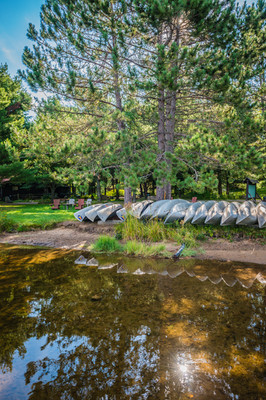Play

Play
You can be as social and active or as solitary as you wish at Arowhon Pines.
On-site
• Tennis and pickle ball; we can arrange partners if you wish
• There are two hockey nets and sticks for road hockey
• Sauna
• Horseshoes
• Badminton
• Games Room with library
• TV room with movies, ping pong, piano, shuffleboard and board games
Many guests bring their own bikes. You can ride on the Arowhon Road but please ride with care as there is traffic. It is best to use the Park bike trails — Minessing and Lake of Two Rivers Railway trail.
Land
The rich terrain of Algonquin Park is yours to explore in a variety of ways. Sit back and take in the natural kaleidoscope of colour from your deck chair, or delve into the landscape through a multitude of hiking and walking trails. Arowhon offers trails adjacent to the property and there are 16 spectacular park trails to explore as well.
There are old railway roads to follow, the remnants of an old mill to find and the unmarked grave of Tom Thompson to visit plus much more... or simply just ramble through a symphony of stillness.
Water
Start your day on the dock and watch the morning mist along the lake. Plunge into the lake and stretch out your limbs with a refreshing swim or paddle a canoe on a day trip. Explore a series of lakes, streams and narrows, with names like Lost Joe Lake, Burnt Island and Tom Thomson. Stop anytime along the shore for a picnic lunch, rest and a swim.
First timers can receive basic canoe instruction. There are sturdy aluminum canoes for novice paddlers and light weight Kevlar canoes for the more experienced who plan to portage. Slow down and watch the natural beauty unfold from your kayak. Try letting the wind carry you around Little Joe Lake on our sailboats or give our stand up paddle boards a spin for a new perspective.
Algonquin Park
Registered guests are given a complimentary vehicle pass to explore Algonquin Park for the duration of their stay.
Established in 1893, Algonquin is Ontario’s first provincial park and it attracts over half a million visitors annually. Occupying 7,630 square kilometers of land and water, it includes an extensive network of canoe routes, hiking trails and campsites.
Activities in Algonquin Park include:
-
16 interpretive walking trails ranging from 0.8–11 km in length
-
Spectacular Algonquin Park Visitors' Centre with exhibits on park wildlife and human history, theatre, bookstore and a breathtaking panoramic viewing deck
-
Mountain bike trails (bring your own bikes or rentals are available nearby)
-
Nature lectures and guided leisurely hikes
-
Canoe outings on Park Lake
-
Outdoor theatre events
-
Public wolf howls
-
Art in the park- special exhibits such as painting, sculptures, and photography
-
Mushroom and wildflower walks
-
Animal tracks and night noises
-
Logging museum
-
Children’s programmes
Check out the Algonquin Park Weekly Events Calendar
Click to view Algonquin Park live: Algonquin Park Live Webcam
Friends of Algonquin Park: www.algonquinpark.on.ca/foap
Seasoned and budding naturalists alike look forward to catching of glimpse of Algonquin’s legendary wildlife. You don’t have to roam far to see wild animals that call the Park home.
Moose. Deer. Fox. Black Bears. Lots of birds. Loons. Herons. Turtles. Fish. Beavers. Otters. And more!
Nature & Wildlife
There are over 40 mammals, over 30 kinds of reptiles and amphibians (none are venomous), and more than 130 breeding birds.
Some wildlife viewing tips, courtesy of www.algonquinpark.on.ca:
-
Go out in the evening or, better still, at dawn and the two or three hours which follow. Early morning is the best time to see birds and mammals; it is the coolest, most beautiful part of the day and one which you will have almost entirely to yourself, even when the Park is full.
-
Take binoculars. They are indispensable when looking at birds but are useful also for getting close-up views of large mammals.
-
Concentrate on low-lying, wet areas such as bogs, ponds, and beaver meadows. These places are the preferred habitat of many wildlife species and they often provide open vistas or breaks in the thick forest making for excellent wildlife viewing.
-
Be careful! If you stop to watch wildlife along the highway, remember to pull onto the shoulder, safely off the pavement. Watch for traffic especially if crossing the road! And remember that you are viewing wild animals; stay at a respectful distance at all times!

































